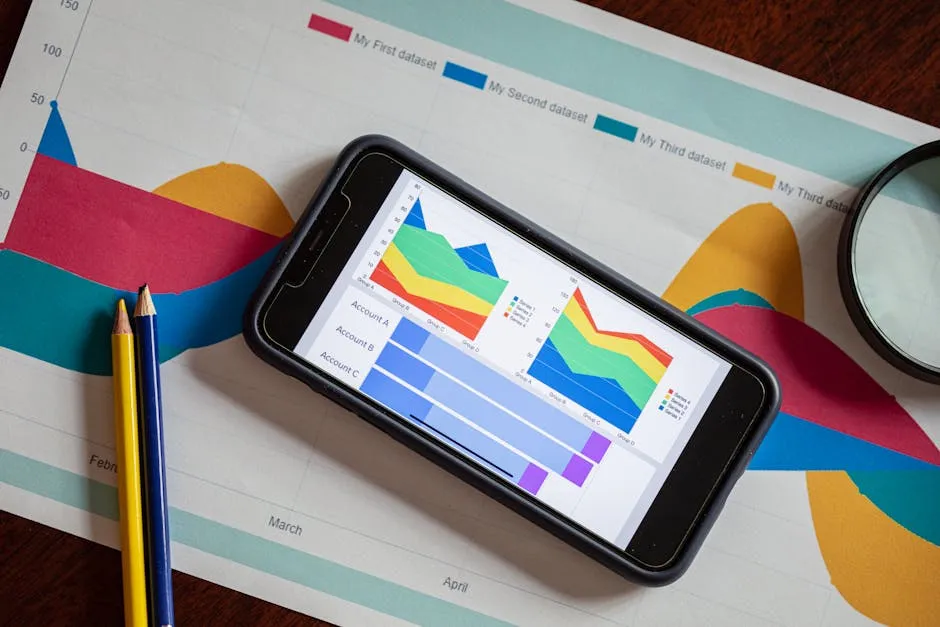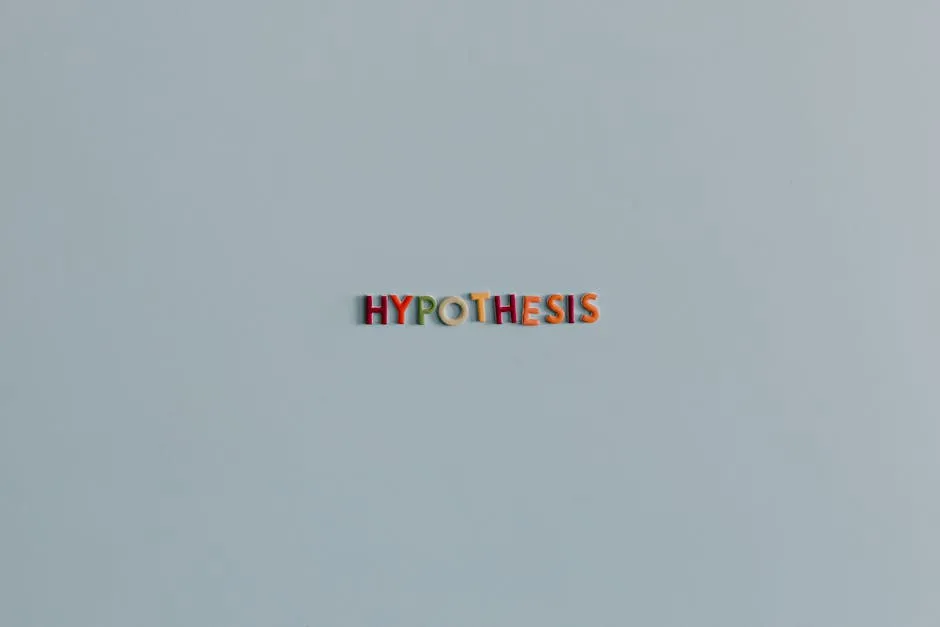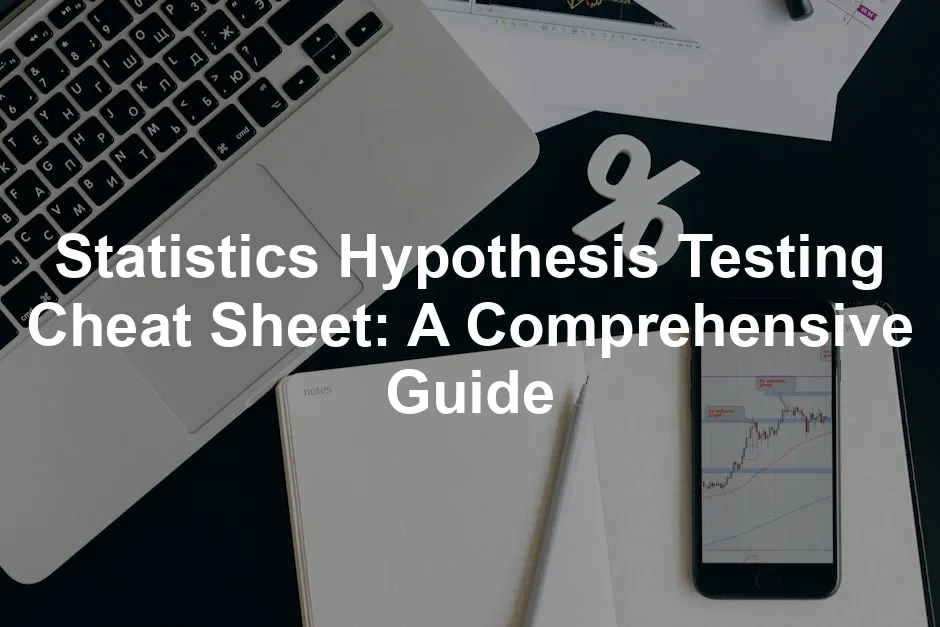Hypotheses:
- Null Hypothesis (H0): The mean weight loss for all diets is equal (μ_diet1 = μ_diet2 = μ_diet3).
- Alternative Hypothesis (H1): At least one diet leads to different mean weight loss (not all means are equal).
Statistical Method: Use one-way ANOVA. This test assesses the means of three or more groups. You’ll calculate the F-statistic by analyzing variance between the groups and within each group. If the p-value is less than your significance level, you reject H0, concluding that at least one diet is significantly different from the others.

Example 4: Correlation Testing (Pearson’s Correlation)
Lastly, let’s look at the relationship between hours studied and exam scores.
Scenario: You want to determine if there’s a correlation between study time and test performance.
Hypotheses:
- Null Hypothesis (H0): There is no correlation between study hours and exam scores (ρ = 0).
- Alternative Hypothesis (H1): There is a correlation between study hours and exam scores (ρ ≠ 0).
Statistical Method: Pearson’s correlation coefficient is your go-to here. Calculate the correlation coefficient using your data. If the resulting p-value is below your significance level, you reject H0, indicating a significant correlation between study time and performance.

Conclusion
In summary, hypothesis testing is essential in statistics. It allows researchers and decision-makers to draw conclusions from data confidently. Understanding various tests, like t-tests, chi-square tests, ANOVA, and correlation testing, equips you to tackle real-world problems effectively.
These examples illustrate how hypothesis testing can be applied to various practical scenarios. By practicing these concepts, you can gain insights into data and enhance your decision-making abilities.
If you’re eager to dive deeper, explore additional resources such as textbooks or online courses that focus on statistics and hypothesis testing. The more you practice, the more proficient you’ll become! And for those who enjoy visual aids, consider investing in Statistical Charts and Graphs Posters to help visualize complex data!
FAQs
What is the difference between Type I and Type II errors?
Type I and Type II errors are critical concepts in hypothesis testing. Think of them as the two villains in our statistical saga. A Type I error occurs when we reject the null hypothesis (H0) when it is actually true. This false positive can lead to incorrect conclusions, like declaring a new drug effective when it’s not. The probability of making a Type I error is denoted by alpha (α), often set at 0.05. On the other hand, a Type II error happens when we fail to reject H0 when it is false. This false negative might mean missing out on a breakthrough treatment. The probability of this error is represented by beta (β). Balancing these errors is crucial in hypothesis testing. Lowering the chance of one often increases the risk of the other. So, tread carefully!
How do I choose the right statistical test?
Choosing the right statistical test is like picking the perfect tool for a job. It’s essential to match the test with your data and research question. First, consider the type of data you have. Is it categorical or continuous? For example, if you’re comparing means, a t-test might be appropriate. If you have categorical data looking for relationships, a chi-square test is your go-to. Next, think about your sample size. Smaller samples might require a t-test, while larger samples can often use a z-test. Lastly, understand your hypotheses. Are you testing for differences or relationships? This clarity will guide you in selecting the proper test. When in doubt, consult statistical guidelines or use online calculators to help you navigate this maze.
What are the common pitfalls in hypothesis testing?
Ah, the slippery slopes of hypothesis testing! Many researchers stumble here. One common pitfall is the misuse of p-values. A p-value less than 0.05 doesn’t guarantee that your findings are practically significant. It merely indicates statistical significance. Another error is neglecting to check assumptions. Each test has specific prerequisites. For instance, t-tests require normally distributed data. Ignoring this can lead to invalid results. Also, researchers often forget to report effect sizes. While p-values tell us if an effect exists, effect sizes reveal how substantial that effect is. Lastly, over-reliance on statistical tests without considering context can lead to misleading conclusions. Always interpret results within the broader framework of your research.
Can hypothesis testing be applied in machine learning?
Absolutely! Hypothesis testing is not just a relic of traditional statistics; it has a vital role in machine learning too. For example, it helps evaluate whether a new algorithm significantly outperforms an existing one. In model selection, hypothesis tests can compare the performances of various models. For instance, you might want to see if a complex model delivers better predictions compared to a simpler one. Moreover, hypothesis testing can assist in feature selection. By testing whether specific features significantly impact the target variable, you can refine your model. So yes, machine learning and hypothesis testing are like peanut butter and jelly—perfect together!
How do I interpret p-values effectively?
Interpreting p-values can feel like deciphering a secret code. Let’s break it down! A p-value indicates the probability of observing your data, or something more extreme, assuming the null hypothesis is true. If your p-value is less than or equal to your significance level (often 0.05), you reject the null hypothesis. This suggests strong evidence against H0. However, don’t jump to conclusions! A small p-value doesn’t imply a strong effect or practical significance. Conversely, a large p-value means insufficient evidence to reject H0. But remember, failing to reject H0 doesn’t prove it’s true; it just indicates a lack of evidence against it. Always consider the context of your research and the size of the effect when interpreting p-values.
Please let us know what you think about our content by leaving a comment down below!
Thank you for reading till here 🙂
For those looking to refine their skills in statistical methods for finance professionals 2024, understanding these concepts is crucial.
To enhance your data analysis skills, consider checking out tips for effective data analysis in economics and statistics.
Understanding the difference between practical significance versus statistical significance is also vital for effective hypothesis testing.
If you’re keen on statistical inference, check out statistical inference for estimation in data science colorado for further insights.
Finally, for those interested in calculating test statistics, this guide on how to calculate test statistic for confidence interval ti84 will be beneficial.
All images from Pexels
Hypotheses:
- Null Hypothesis (H0): The proportion of customers preferring Brand A equals the expected proportion (p_A = p_expected).
- Alternative Hypothesis (H1): The proportion of customers preferring Brand A differs from the expected (p_A ≠ p_expected).
Statistical Method: A chi-square test for independence is the way to go. This test analyzes the frequency data from your survey. Calculate the observed and expected counts, then apply the chi-square formula. If your chi-square statistic results in a p-value less than the significance level, you reject H0, indicating a significant preference for one brand.

Example 3: Comparison of Multiple Groups (ANOVA)
Consider a study involving three different diets to see which one leads to the most weight loss.
Scenario: You want to compare weight loss across three groups following different diets.
Hypotheses:
- Null Hypothesis (H0): The mean weight loss for all diets is equal (μ_diet1 = μ_diet2 = μ_diet3).
- Alternative Hypothesis (H1): At least one diet leads to different mean weight loss (not all means are equal).
Statistical Method: Use one-way ANOVA. This test assesses the means of three or more groups. You’ll calculate the F-statistic by analyzing variance between the groups and within each group. If the p-value is less than your significance level, you reject H0, concluding that at least one diet is significantly different from the others.

Example 4: Correlation Testing (Pearson’s Correlation)
Lastly, let’s look at the relationship between hours studied and exam scores.
Scenario: You want to determine if there’s a correlation between study time and test performance.
Hypotheses:
- Null Hypothesis (H0): There is no correlation between study hours and exam scores (ρ = 0).
- Alternative Hypothesis (H1): There is a correlation between study hours and exam scores (ρ ≠ 0).
Statistical Method: Pearson’s correlation coefficient is your go-to here. Calculate the correlation coefficient using your data. If the resulting p-value is below your significance level, you reject H0, indicating a significant correlation between study time and performance.

Conclusion
In summary, hypothesis testing is essential in statistics. It allows researchers and decision-makers to draw conclusions from data confidently. Understanding various tests, like t-tests, chi-square tests, ANOVA, and correlation testing, equips you to tackle real-world problems effectively.
These examples illustrate how hypothesis testing can be applied to various practical scenarios. By practicing these concepts, you can gain insights into data and enhance your decision-making abilities.
If you’re eager to dive deeper, explore additional resources such as textbooks or online courses that focus on statistics and hypothesis testing. The more you practice, the more proficient you’ll become! And for those who enjoy visual aids, consider investing in Statistical Charts and Graphs Posters to help visualize complex data!
FAQs
Please let us know what you think about our content by leaving a comment down below!
Thank you for reading till here 🙂
For those looking to refine their skills in statistical methods for finance professionals 2024, understanding these concepts is crucial.
To enhance your data analysis skills, consider checking out tips for effective data analysis in economics and statistics.
Understanding the difference between practical significance versus statistical significance is also vital for effective hypothesis testing.
If you’re keen on statistical inference, check out statistical inference for estimation in data science colorado for further insights.
Finally, for those interested in calculating test statistics, this guide on how to calculate test statistic for confidence interval ti84 will be beneficial.
All images from Pexels
Hypotheses:
- Null Hypothesis (H0): The mean productivity before training equals the mean after training (μ_before = μ_after).
- Alternative Hypothesis (H1): The mean productivity after training is greater than before (μ_after > μ_before).
Statistical Method: You would use a paired t-test. This test compares the means of two related groups. First, calculate the mean productivity before and after training. Then, compute the t-statistic and the corresponding p-value. If the p-value is less than your significance level (e.g., 0.05), you reject H0, concluding that the training program significantly improved productivity.

Example 2: Proportion Comparison (Chi-Square Test)
Now, picture a scenario where you’re evaluating customer preference between two brands of cereal.
Scenario: You conducted a survey and want to see if there’s a significant preference for Brand A over Brand B.
Hypotheses:
- Null Hypothesis (H0): The proportion of customers preferring Brand A equals the expected proportion (p_A = p_expected).
- Alternative Hypothesis (H1): The proportion of customers preferring Brand A differs from the expected (p_A ≠ p_expected).
Statistical Method: A chi-square test for independence is the way to go. This test analyzes the frequency data from your survey. Calculate the observed and expected counts, then apply the chi-square formula. If your chi-square statistic results in a p-value less than the significance level, you reject H0, indicating a significant preference for one brand.

Example 3: Comparison of Multiple Groups (ANOVA)
Consider a study involving three different diets to see which one leads to the most weight loss.
Scenario: You want to compare weight loss across three groups following different diets.
Hypotheses:
- Null Hypothesis (H0): The mean weight loss for all diets is equal (μ_diet1 = μ_diet2 = μ_diet3).
- Alternative Hypothesis (H1): At least one diet leads to different mean weight loss (not all means are equal).
Statistical Method: Use one-way ANOVA. This test assesses the means of three or more groups. You’ll calculate the F-statistic by analyzing variance between the groups and within each group. If the p-value is less than your significance level, you reject H0, concluding that at least one diet is significantly different from the others.

Example 4: Correlation Testing (Pearson’s Correlation)
Lastly, let’s look at the relationship between hours studied and exam scores.
Scenario: You want to determine if there’s a correlation between study time and test performance.
Hypotheses:
- Null Hypothesis (H0): There is no correlation between study hours and exam scores (ρ = 0).
- Alternative Hypothesis (H1): There is a correlation between study hours and exam scores (ρ ≠ 0).
Statistical Method: Pearson’s correlation coefficient is your go-to here. Calculate the correlation coefficient using your data. If the resulting p-value is below your significance level, you reject H0, indicating a significant correlation between study time and performance.

Conclusion
In summary, hypothesis testing is essential in statistics. It allows researchers and decision-makers to draw conclusions from data confidently. Understanding various tests, like t-tests, chi-square tests, ANOVA, and correlation testing, equips you to tackle real-world problems effectively.
These examples illustrate how hypothesis testing can be applied to various practical scenarios. By practicing these concepts, you can gain insights into data and enhance your decision-making abilities.
If you’re eager to dive deeper, explore additional resources such as textbooks or online courses that focus on statistics and hypothesis testing. The more you practice, the more proficient you’ll become! And for those who enjoy visual aids, consider investing in Statistical Charts and Graphs Posters to help visualize complex data!
FAQs
Please let us know what you think about our content by leaving a comment down below!
Thank you for reading till here 🙂
For those looking to refine their skills in statistical methods for finance professionals 2024, understanding these concepts is crucial.
To enhance your data analysis skills, consider checking out tips for effective data analysis in economics and statistics.
Understanding the difference between practical significance versus statistical significance is also vital for effective hypothesis testing.
If you’re keen on statistical inference, check out statistical inference for estimation in data science colorado for further insights.
Finally, for those interested in calculating test statistics, this guide on how to calculate test statistic for confidence interval ti84 will be beneficial.
All images from Pexels
Introduction
Hypothesis testing is a cornerstone of statistical analysis. It’s the method we use to determine whether a statement about a population is likely true or false based on sample data. This technique is essential in various fields, from scientific research to business decision-making, as it provides a systematic framework for evaluating claims and making informed choices.
Imagine you’re a scientist trying to prove that a new medication works better than the existing one. You can’t just assume it does; you need evidence. That’s where hypothesis testing steps in. It allows you to formulate a claim, collect data, and use statistical methods to either support or refute your hypothesis.
This cheat sheet is tailored for students, data analysts, and researchers who want a handy reference to understand the basics of hypothesis testing. Whether you’re navigating through a statistics class or diving into data analysis at work, this guide will illuminate key concepts and practical applications.
In this article, you can expect to learn about the fundamental aspects of hypothesis testing, including definitions, types of hypotheses, and the significance level. We’ll discuss the p-value and its role in decision-making, plus the critical region where those decisions are made. You’ll also encounter practical examples to better grasp these concepts, making your journey through hypothesis testing a lot less daunting. So, grab your favorite beverage, and let’s get started on this statistical adventure!
If you’re looking for a solid introduction to statistics, check out Statistics for Dummies. This book breaks down complex concepts into bite-sized pieces, making it perfect for those new to the field.

Key Concepts
What is Hypothesis Testing?
Hypothesis testing is a statistical method used to make decisions based on data. Think of it as a courtroom trial for your data. You have two contenders: the null hypothesis (H0) and the alternative hypothesis (H1). H0 claims there’s no effect or difference, while H1 suggests there is. Your goal is to evaluate these hypotheses using sample data.
This method is crucial because it allows researchers to make inferences about a population from a sample. It provides a structured approach to deciding whether to accept or reject a claim. Without hypothesis testing, conclusions drawn from data could be mere conjectures.
To dive deeper into statistical concepts, consider picking up The Art of Statistics: Learning from Data. It’s a fantastic resource that teaches you how to think critically about data and statistics.

Types of Hypotheses
In hypothesis testing, we primarily deal with two types of hypotheses:
- Null Hypothesis (H0): This is the default assumption. It states that there is no significant effect or difference. For example, if you’re testing a new drug, H0 might say, “The drug has no effect on patients.”
- Alternative Hypothesis (H1): This is what you hope to support. It indicates the presence of an effect or difference. Continuing with our drug example, H1 would state, “The drug improves patient outcomes.”
For those who want to understand more about the nuances of hypothesis testing, grab Hypothesis Testing: A Practical Guide. This book offers a straightforward approach to understanding the process of hypothesis testing.

Significance Level (α)
The significance level, often denoted as α, is a threshold that helps us decide whether to reject the null hypothesis. Common values are 0.05 and 0.01. Setting α at 0.05 means you’re willing to accept a 5% chance of incorrectly rejecting H0 when it’s true.
The significance level plays a critical role in hypothesis testing. It establishes the criteria for making decisions based on p-values. A lower α indicates a stricter criterion for rejecting H0, which is crucial when the consequences of a false positive are severe.
If you’re interested in statistical methods for social sciences, consider checking out Statistical Methods for the Social Sciences. This book provides practical insights into applying statistical methods within social research.

P-value
The p-value is the probability of observing the data, or something more extreme, if the null hypothesis is true. It quantifies evidence against H0. If the p-value is less than or equal to α, we reject the null hypothesis.
For instance, if you obtain a p-value of 0.03 at a significance level of 0.05, you have enough evidence to reject H0. However, if your p-value is 0.08, you fail to reject H0, implying that your evidence is insufficient.
For those who wish to delve deeper into the world of statistics, Naked Statistics: Stripping the Dread from the Data provides an engaging and entertaining overview of statistical principles.

Critical Region
The critical region is the set of values that leads to the rejection of the null hypothesis. It’s determined based on the significance level and the statistical test used. When your test statistic falls into this region, it indicates that the observed data is unlikely under the null hypothesis.
Understanding the critical region is vital for hypothesis testing. It helps visualize where you stand in relation to the null hypothesis and reinforces the decision-making process. By effectively identifying this area, you can confidently conclude whether to accept or reject H0.

Hypothesis Testing Steps
Step 1: State the Hypotheses
First things first, you need to state your hypotheses. Think of this as setting the stage for your statistical showdown.
- Null Hypothesis (H0): This is the default claim, assuming there’s no effect or difference. For example, if you’re testing a new fertilizer, H0 might be: “This fertilizer has no impact on plant growth.”
- Alternative Hypothesis (H1): This is what you’re trying to prove. It contradicts H0 and suggests that there is an effect or difference. In our fertilizer example, H1 would say: “This fertilizer increases plant growth.”
Clarity is key here. Make sure both hypotheses are specific and testable. A well-formulated hypothesis leads to a smoother testing process.
If you want to refine your understanding of hypothesis testing, consider Practical Statistics for Data Scientists. This book provides practical techniques that can enhance your statistical analysis skills.

Step 2: Select the Significance Level (α)
Next, it’s time to choose your significance level, commonly denoted as α. This level determines how much risk you’re willing to take in rejecting the null hypothesis when it’s actually true.
Most researchers play it safe with α set at 0.05. This means you’re allowing a 5% chance of making a Type I error, which is like saying, “Oops, I thought the fertilizer worked, but it actually doesn’t!”
Setting α too low can lead to missed opportunities (Type II errors), while setting it too high may lead to false positives. Remember, balance is essential.

Step 3: Choose the Appropriate Test
Now, let’s talk tests! Not the pop quizzes from high school, but the statistical tests that help you analyze your data.
- t-tests: Ideal for comparing means between two groups. For example, comparing plant growth with and without the fertilizer.
- Chi-square tests: Great for categorical data. If you want to see if different fertilizers impact growth rates differently across several plant types, this is your go-to.
- ANOVA (Analysis of Variance): When you have three or more groups to compare. Say you want to test the effectiveness of three different fertilizers. ANOVA helps determine if at least one is significantly different.
Factors influencing test selection include data type (continuous or categorical) and sample size. Choose wisely!
For an excellent resource on statistical tests, consider Discovering Statistics Using IBM SPSS Statistics. This book is perfect for beginners and provides a comprehensive overview of statistical analysis using SPSS.

Step 4: Collect Data and Calculate Test Statistic
Time to roll up your sleeves and get to work! Collect your data meticulously.
Use surveys, experiments, or existing databases, but ensure accuracy. After gathering data, calculate the test statistic relevant to your chosen test. For instance, if you’re using a t-test, you’ll compute the t-statistic based on your sample means and standard deviations.
Remember, garbage in, garbage out. Quality data leads to reliable conclusions.
For those who want to enhance their data analysis skills, consider Statistical Software for Data Analysis. This resource helps you navigate various software options available for your statistical needs.

Step 5: Determine the P-value
With your test statistic in hand, it’s time to find the p-value. This number tells you how likely it is to observe your data, or something more extreme, if H0 is true.
For example, if your p-value is 0.03, it means there’s a 3% chance of seeing the results if the null hypothesis is correct. A smaller p-value strengthens your case against H0.

Step 6: Compare P-value with α
This is the nail-biting moment! Compare your p-value to the significance level (α).
- If p-value ≤ α: You reject the null hypothesis. Congratulations, you’ve found evidence supporting your alternative hypothesis!
- If p-value > α: You fail to reject H0. This doesn’t prove H0 is true; it simply means you didn’t find strong enough evidence against it.

Step 7: Make a Conclusion
Lastly, document your findings. Summarize the results clearly. Did you reject or fail to reject H0?
Interpret the implications of your findings. In our fertilizer example, if you rejected H0, you might conclude that the fertilizer is effective in boosting plant growth.
Don’t forget to share the context of your results! This helps others understand the significance of your findings.

Types of Errors
Type I Error (False Positive)
A Type I error occurs when you reject the null hypothesis when it’s actually true. It’s like declaring victory in a game you didn’t win.
- Definition: Rejecting H0 when it is true.
- Implications: This error can lead to false claims, unnecessary changes, and wasted resources.
For instance, if you conclude that a new medication works when it doesn’t, patients might receive ineffective treatment. Always be cautious about the implications of your findings!

Type II Error (False Negative)
- Definition: A Type II error occurs when we fail to reject the null hypothesis (H0) while it is false. In other words, we might think everything is fine when, in reality, something significant is happening. It’s akin to ignoring a fire alarm because you’re convinced your toast just burnt.
- Implications: The consequences of a Type II error can be serious. Imagine a medical test that fails to detect a disease. Patients might not receive the necessary treatment or interventions, leading to worsening conditions or even fatalities. Furthermore, in business, overlooking an opportunity for improvement could result in lost profits. Essentially, this error can lead to complacency, allowing genuine issues to fester unnoticed.
Balancing Errors
Now, let’s talk about the balancing act between Type I and Type II errors. Picture a tightrope walker—too much weight on either side can lead to disaster.
When we set our significance level (α) low to reduce the risk of a Type I error (false positive), we inadvertently increase the chances of a Type II error (false negative). It’s a classic case of “you can’t have your cake and eat it too.”
To manage this trade-off, consider the following strategies:
- Adjust the Significance Level: Increase α to reduce Type II errors, but be cautious as this raises Type I error risks.
- Increase Sample Size: A larger sample often provides more reliable results, leading to greater test power. It’s like having more eyes on the prize—better detection of real effects.
- Choose the Right Test: Different tests have different power levels. Opt for tests that suit your data and hypotheses to optimize your chances of correctly detecting true effects.
- Understand Context: Weigh the consequences of each error type in your specific scenario. If a false positive could lead to significant harm, prioritize minimizing it. Conversely, if failing to detect a true effect can cause major issues, focus on reducing false negatives.
In essence, navigating these errors is about finding the sweet spot where decision-making is both informed and prudent. Balancing errors is essential in maintaining integrity in hypothesis testing.

Common Statistical Tests
Overview of Tests
When it comes to hypothesis testing, not all tests are created equal. Let’s highlight the most popular ones:
- Z-tests and T-tests: These are your go-to methods for hypothesis testing involving means. Use Z-tests when your sample size is large and the population variance is known. T-tests are perfect for smaller samples or when the population variance remains elusive.
- Chi-Square Tests: Ideal for categorical data, these tests help determine if there’s a significant association between two variables. Think of them as the detectives of the statistic world, uncovering relationships hidden in the data.
- ANOVA (Analysis of Variance): When you need to compare means among three or more groups, ANOVA is your best friend. It helps reveal whether at least one group differs significantly from the others.
- F-tests: These tests compare the variances of two or more groups. They’re particularly helpful in determining if different groups exhibit different levels of variability.
Detailed Descriptions of Each Test
- Z-test: Use this for large sample sizes (n > 30) when the population variance is known. For example, testing if a new training program significantly increases employee productivity compared to the national average. Assumptions include normality and independent samples.
- T-test: There are three types:
- Independent T-test: Compares means from two different groups, like testing the effectiveness of two different fertilizers on plant growth.
- Paired T-test: Used for related groups, like measuring the same group’s performance before and after an intervention.
- One-sample T-test: Compares the mean of a single group to a known value, such as testing if a class’s average score differs from a state average.
- Chi-Square Test:
- Goodness of Fit Test: Determines if observed data fits a specific distribution. For example, testing if a die is fair.
- Test for Independence: Checks if two categorical variables are independent. For instance, examining whether gender influences voting preference.
- ANOVA:
- One-way ANOVA: Compares means across three or more groups. Imagine you’re testing the effects of three different diets on weight loss.
- Two-way ANOVA: Examines the impact of two independent variables. Picture studying how both diet and exercise affect weight loss results.
Choosing the right test is crucial for valid results. Each test comes with its assumptions and best-use scenarios, so be sure to select wisely!
If you’re looking for a comprehensive guide to statistical inference, consider Statistical Inference. This resource dives deep into the techniques and applications of statistical inference.
Examples of Statistics Hypothesis Testing
Example 1: Mean Comparison (T-Test)
Imagine you’re a manager eager to see if a new training program boosts employee productivity. You measure productivity before and after the training for a group of employees.
Scenario: You want to know if the training had a significant effect.
Hypotheses:
- Null Hypothesis (H0): The mean productivity before training equals the mean after training (μ_before = μ_after).
- Alternative Hypothesis (H1): The mean productivity after training is greater than before (μ_after > μ_before).
Statistical Method: You would use a paired t-test. This test compares the means of two related groups. First, calculate the mean productivity before and after training. Then, compute the t-statistic and the corresponding p-value. If the p-value is less than your significance level (e.g., 0.05), you reject H0, concluding that the training program significantly improved productivity.

Example 2: Proportion Comparison (Chi-Square Test)
Now, picture a scenario where you’re evaluating customer preference between two brands of cereal.
Scenario: You conducted a survey and want to see if there’s a significant preference for Brand A over Brand B.
Hypotheses:
- Null Hypothesis (H0): The proportion of customers preferring Brand A equals the expected proportion (p_A = p_expected).
- Alternative Hypothesis (H1): The proportion of customers preferring Brand A differs from the expected (p_A ≠ p_expected).
Statistical Method: A chi-square test for independence is the way to go. This test analyzes the frequency data from your survey. Calculate the observed and expected counts, then apply the chi-square formula. If your chi-square statistic results in a p-value less than the significance level, you reject H0, indicating a significant preference for one brand.

Example 3: Comparison of Multiple Groups (ANOVA)
Consider a study involving three different diets to see which one leads to the most weight loss.
Scenario: You want to compare weight loss across three groups following different diets.
Hypotheses:
- Null Hypothesis (H0): The mean weight loss for all diets is equal (μ_diet1 = μ_diet2 = μ_diet3).
- Alternative Hypothesis (H1): At least one diet leads to different mean weight loss (not all means are equal).
Statistical Method: Use one-way ANOVA. This test assesses the means of three or more groups. You’ll calculate the F-statistic by analyzing variance between the groups and within each group. If the p-value is less than your significance level, you reject H0, concluding that at least one diet is significantly different from the others.

Example 4: Correlation Testing (Pearson’s Correlation)
Lastly, let’s look at the relationship between hours studied and exam scores.
Scenario: You want to determine if there’s a correlation between study time and test performance.
Hypotheses:
- Null Hypothesis (H0): There is no correlation between study hours and exam scores (ρ = 0).
- Alternative Hypothesis (H1): There is a correlation between study hours and exam scores (ρ ≠ 0).
Statistical Method: Pearson’s correlation coefficient is your go-to here. Calculate the correlation coefficient using your data. If the resulting p-value is below your significance level, you reject H0, indicating a significant correlation between study time and performance.

Conclusion
In summary, hypothesis testing is essential in statistics. It allows researchers and decision-makers to draw conclusions from data confidently. Understanding various tests, like t-tests, chi-square tests, ANOVA, and correlation testing, equips you to tackle real-world problems effectively.
These examples illustrate how hypothesis testing can be applied to various practical scenarios. By practicing these concepts, you can gain insights into data and enhance your decision-making abilities.
If you’re eager to dive deeper, explore additional resources such as textbooks or online courses that focus on statistics and hypothesis testing. The more you practice, the more proficient you’ll become! And for those who enjoy visual aids, consider investing in Statistical Charts and Graphs Posters to help visualize complex data!
FAQs
Please let us know what you think about our content by leaving a comment down below!
Thank you for reading till here 🙂
For those looking to refine their skills in statistical methods for finance professionals 2024, understanding these concepts is crucial.
To enhance your data analysis skills, consider checking out tips for effective data analysis in economics and statistics.
Understanding the difference between practical significance versus statistical significance is also vital for effective hypothesis testing.
If you’re keen on statistical inference, check out statistical inference for estimation in data science colorado for further insights.
Finally, for those interested in calculating test statistics, this guide on how to calculate test statistic for confidence interval ti84 will be beneficial.
All images from Pexels




